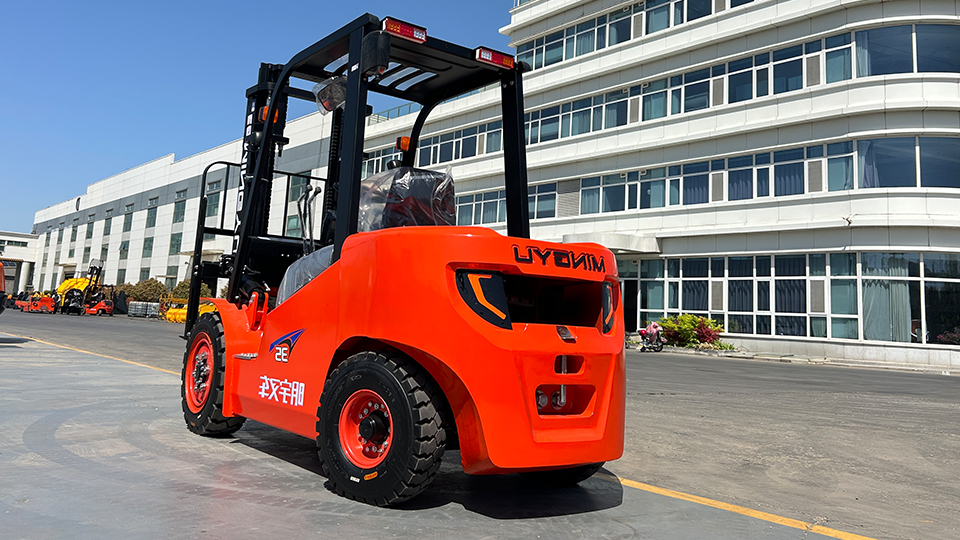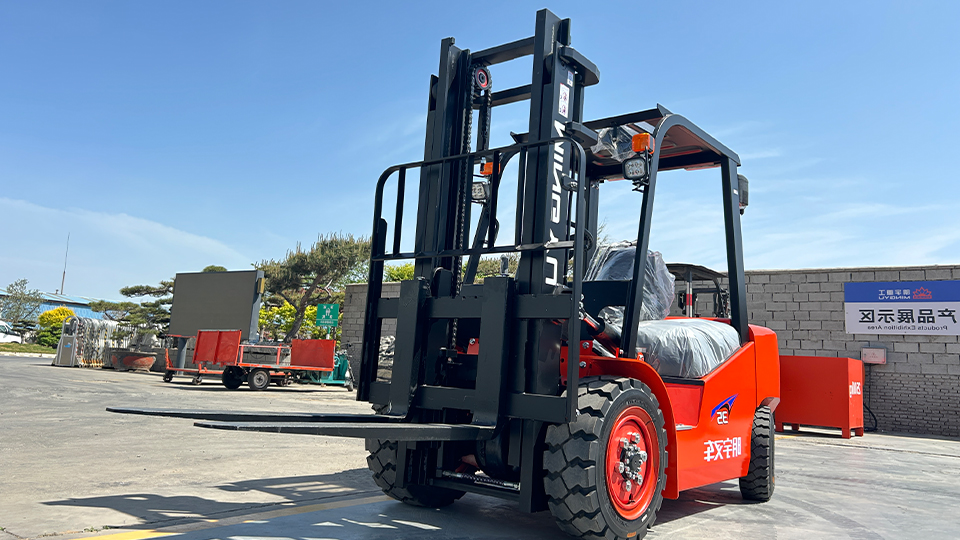
Single-stage mast: Offers a single vertical reach.

Steering and Maneuverability: Forklifts typically employ rear-wheel steering, which provides a tight turning radius, making them highly maneuverable in confined spaces like warehouse aisles. However, rear-wheel steering also requires careful operation, as the rear of the forklift swings out significantly during turns.
Load Stability During Transport: The design of the forklift, particularly its low center of gravity and the positioning of the load close to the front axle, contributes to stability during transport. However, factors like uneven surfaces, excessive speed, and improperly balanced loads can still compromise stability.
Specialized Functions and Attachments
While lifting, lowering, and transporting are the core functions, the versatility of a forklift is significantly enhanced by the wide range of attachments that can be easily mounted to the carriage in place of the standard forks. These attachments allow forklifts to perform a multitude of specialized tasks:
Clamps: Designed to grip and lift items without pallets, such as rolls of paper, bales of cotton, or appliances. Different types of clamps cater to various shapes and materials.
Sideshifters: Allow the operator to move the carriage and load laterally (side-to-side) without moving the entire forklift, facilitating precise placement in tight spaces.
Rotators: Enable the operator to rotate the forks or attachments, allowing for the dumping of bins or the repositioning of loads.
Push/Pull Attachments: Used for handling slip sheets (thin fiberboard or plastic sheets) instead of pallets, often employed in industries like food and beverage.
Single/Double Pallet Handlers: Allow the forklift to carry one or two pallets side-by-side, increasing efficiency in high-volume operations.
Carpet Poles: Long, tapered poles used to lift and transport rolls of carpet or other rolled materials.
Drum Handlers: Specialized attachments for safely lifting, transporting, and sometimes rotating drums.
Load Stabilizers: Overhead devices that clamp down on the load to provide extra stability during transport, particularly for tall or нестабильные items.
Personnel Platforms: Safety cages that can be attached to the forklift to elevate personnel for tasks like maintenance or inventory checking (when used according to specific safety regulations).
The availability of these attachments transforms a basic lifting and transporting machine into a highly adaptable tool capable of handling a vast array of materials and tasks.
Design Elements Contributing to Functionality
Several key design elements of a forklift contribute to its ability to perform its intended functions effectively and safely:
Frame and Chassis: The robust frame provides the structural integrity and stability necessary to support heavy loads. The low center of gravity is a critical design feature that helps prevent tipping.
Mast Assembly: As discussed earlier, the mast and hydraulic system are crucial for vertical lifting and lowering. The design of the mast (number of stages, height) dictates the forklift's reach capabilities.
Carriage and Forks: The carriage provides a mounting point for the forks or attachments. Standard forks are typically L-shaped tines designed to engage with pallets or skids. Their length and adjustability are important for handling different load sizes.
Power Source (Engine or Motor): The power source provides the energy for both lifting and movement. The type of power source influences factors like emissions, noise levels, and operating costs, making it a key consideration for different applications.
Transmission and Drive System: The transmission transfers power from the engine or motor to the wheels, enabling controlled movement and speed.
Steering System: The rear-wheel steering mechanism provides the tight turning radius essential for maneuvering in confined spaces.
Braking System: Forklifts are equipped with robust braking systems, including service brakes for regular stopping and parking brakes for securing the machine when not in use.
Safety Features: Modern forklifts incorporate numerous safety features, including:
Overhead guard: Protects the operator from falling objects.
Load backrest extension: Prevents loads from shifting backward onto the operator.
Warning lights and alarms: Increase visibility and audibility.
Operator restraint systems (seat belts, hip restraints): Help keep the operator within the confines of the truck in case of a tip-over.
Stability control systems: Advanced systems that can help prevent rollovers in certain situations.
Lift interlocks: Prevent lifting or lowering when the operator is not properly seated.
Diverse Applications Across Industries
The fundamental ability to lift, lower, and transport materials makes forklifts indispensable across a wide range of industries:
Warehousing and Logistics: Moving pallets of goods, loading and unloading trucks and railcars, stacking and retrieving items from shelves.
Manufacturing: Transporting raw materials, components, and finished products within production facilities.
Construction: Moving building materials, equipment, and debris on job sites.
Retail: Stocking shelves in large stores, moving inventory in distribution centers.

Agriculture: Handling feed, fertilizer, and harvested crops.
Ports and Shipping: Loading and unloading cargo from ships and containers.
Waste Management: Moving and compacting waste materials.
In each of these applications, the core functions of the forklift are adapted and utilized to meet the specific material handling needs of the industry.
Conclusion: A Specialized Tool for Material Handling Efficiency
In summary, a forklift is a sophisticated piece of machinery designed primarily to lift, lower, and transport materials efficiently and safely over short distances. Its capabilities are extended through a variety of attachments that enable it to perform specialized tasks. The design of the forklift, encompassing its frame, mast, power source, steering, braking, and safety features, is carefully engineered to ensure stability, maneuverability, and operator protection.
Understanding the fundamental purpose and the diverse capabilities of a forklift is essential for both operators and employers. Proper training, adherence to safety regulations, and the appropriate selection and use of attachments are crucial for maximizing the efficiency and minimizing the risks associated with forklift operations. The forklift, in its various forms and with its adaptable functionalities, remains a cornerstone of modern material handling, playing a vital role in keeping goods moving and industries running smoothly. Its seemingly simple design belies a complex and crucial function in the global economy.
Name: selena
Mobile:+86-13176910558
Tel:+86-0535-2090977
Whatsapp:8613181602336
Email:vip@mingyuforklift.com
Add:Xiaqiu Town, Laizhou, Yantai City, Shandong Province, China